

Mexico Facts for Kids. Did you know?
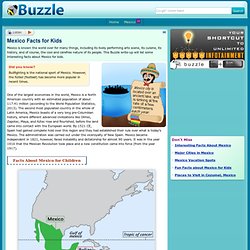
Bullfighting is the national sport of Mexico. However, the fútbol (football) has become more popular in recent times. One of the largest economies in the world, Mexico is a North American country with an estimated population of about 117.41 million (according to the World Population Statistics, 2013). The second most populated country in the whole of Latin America, Mexico boasts of a very long pre-Columbian history, where different advanced civilizations like Olmec, Zapotec, Maya, and Aztec rose and flourished, before the land came into contact with the European world. By 1521 CE, Spain had gained complete hold over this region and they had established their rule over what is today's Mexico. Facts About Mexico for Children Mexico is part of the continent of North America. . ➥ The total area of Mexico is 761,600 sq miles. Golden Eagle is Mexico's national bird. . ➥ The official language of Mexico is Spanish, but they speak other tongues as well.
From National Geographic (Rain Forest) Rainforest Facts for Kids. Did You Know?
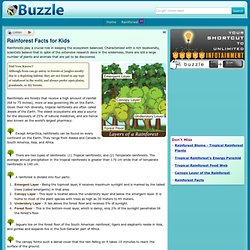
Although lions can go astray in forests or jungles mostly due to a depleting habitat, they are not found in any type of rainforest in the world, and always prefer open plains, grasslands, or dry forests. Rainforests are forests that receive a high amount of rainfall (68 to 75 inches), more or less governing life on the Earth. Given their rich diversity, tropical rainforests are often called Jewels of the Earth. The oldest ecosystems are also a source for the discovery of 25% of natural medicines, and are hence also known as the world's largest pharmacy. Except Antarctica, rainforests can be found on every continent on the Earth. There are two types of rainforests: (1) Tropical rainforests; and (2) Temperate rainforests. A rainforest is divided into four parts: Jaguars live on the forest floor of the South American rainforest, tigers and elephants reside in Asia, and gorillas and leopards live in the Sub-Saharan part of Africa.
According to research done by the U.S. Saving Forests. Page Content These nature-based initiatives aid in global mitigation efforts by preserving or restoring standing forests, which absorb massive amounts of carbon from the atmosphere.
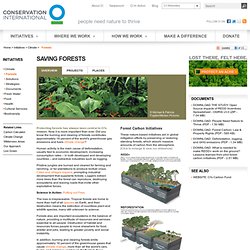
[Click to enlarge & view our slideshow] Protecting forests has always been central to CI's mission. Now it is more important than ever. Weather in the rainforest. Rainforest Plants. Rain Forest Plants. Climate in Tropical Rainforest. Saving Forests. Page Content These nature-based initiatives aid in global mitigation efforts by preserving or restoring standing forests, which absorb massive amounts of carbon from the atmosphere.

[Click to enlarge & view our slideshow] Protecting forests has always been central to CI's mission. Now it is more important than ever. Did you know the burning and clearing of forests contributes approximately 16 percent of the world's greenhouse gas emissions and fuels climate change? Human activity is the main cause of deforestation, usually tied to economic development, increasing consumption rates – in both developed and developing countries – and extractive industries such as logging.
Pristine jungles are burned and cleared for farming and ranching, or for plantations to produce biofuel crops. Science in Action: Putting out Fires. Rainforest Animals. Environment.nationalgeographic. What is a Rainforest? Species Profiles. Birds Mammals Plants Reptiles.
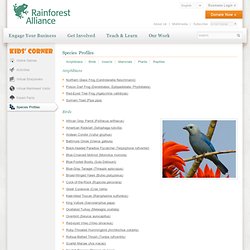
! Dainty Green Tree-frog ! Tropical Rainforest, North Queensland, Australia. What are rainforests? Snakes in the African Rainforest. Rainforest Animals. What makes a rainforest? Endangered Rainforest Animals. Animals are categorized under endangered species if they are at risk of becoming extinct either because of their few numbers or due to the change in the environmental condition.

As per the International Union for Conservation of Nature and Natural Resources (IUCN) data, about 40 percent of the total organisms are on the verge of extinction in the near future. In 1963, the IUCN created the Red Data List of more than 15,500 species, after evaluating the extinction risk of various species and subspecies worldwide. This list is also known as IUCN Red List of Threatened Species or IUCN Red List. Among the many ecosystems, rainforests are those forest areas that are characterized by heavy rainfall (1750 - 2000 mm). Amazon Rainforest Facts for Kids. Animals. Rainforest Facts. Rainforests Facts. Facts about Rainforests Do you know how many tropical rainforest plants have been identified as having anti-cancer properties?
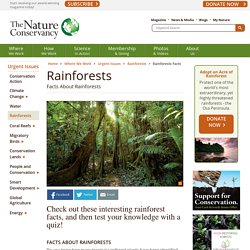
Or how many continents around the world contain rainforests? And just how quickly are the world's rainforests disappearing? Find out the answers to these questions and more as you check out these interesting rainforest facts! And when you think that you know all there is to know about the rainforest, test your knowledge with our rainforest quiz. Blue Planet Biomes - World Biomes. What is a Biome?
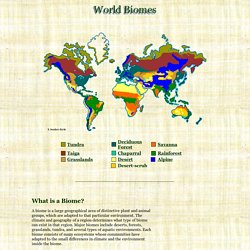
A biome is a large geographical area of distinctive plant and animal groups, which are adapted to that particular environment. The climate and geography of a region determines what type of biome can exist in that region. Major biomes include deserts, forests, grasslands, tundra, and several types of aquatic environments. Bing. Landforms in Tropical Rainforests. The tropical rainforests are characterized by a variety of landforms and which give rise to a complex ecosystem in this region.
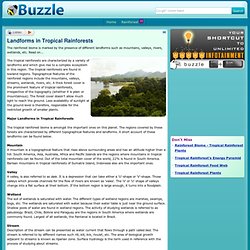
The tropical rainforests are found in lowland regions. Topographical features of the rainforest regions include the mountains, valleys, streams, wetlands, rivers, etc. Layers of the Rainforest. By: C.M.Shorter EMERGENT LAYER The Emergent Layer is the highest level of the Rainforest.
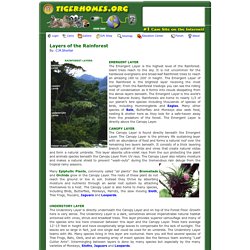
Giant trees reach to the sky. It is not uncommon for the hardwood evergreens and broad-leaf Rainforest trees to reach an amazing 180 to 200’ in height.